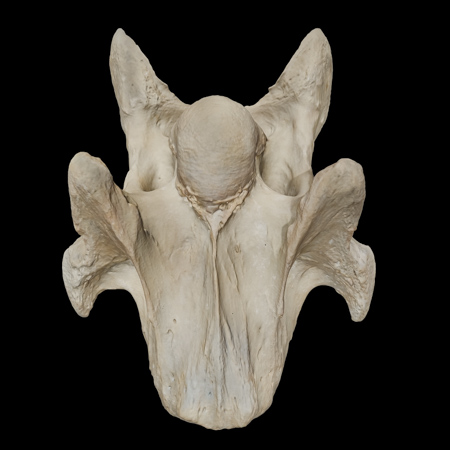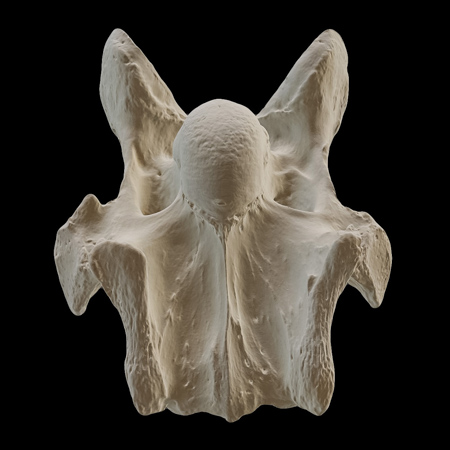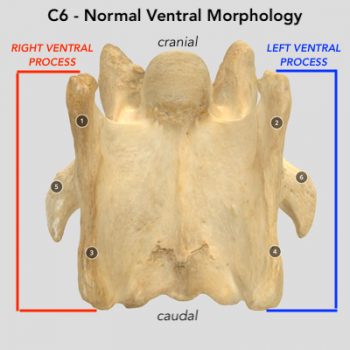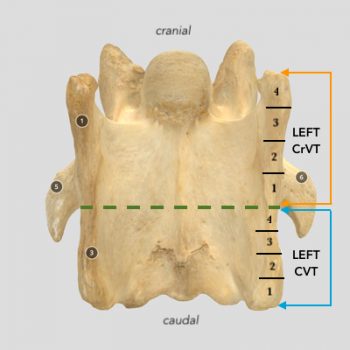
Equus-Soma
Equine Osteology & Anatomy Learning Center

Aiken, SC
info@equus-soma.com
Waldoboro, ME
207-542-6132
ECVM: A Three-Dimensional Point of View
Our recent publication (May-Davis et al., 2023) describing the morphological variations of the sixth cervical vertebrae (C6) in ECVM horses, includes a grading system based on the degree to which bone is missing from the ventral processes. The grades are explained in the paper using photographs of representative bones from the author's cumulative dataset (N=76).
References & Publications
CLICK HERE
To expand on the understanding of ECVM morphology we present here 3D renderings of the bones from our Equus-Soma collection, beginning with C6.
Review of C6 ECVM Grading System

The photo to the left is a ventral view of the same C6 as the 3D model in the right sidebar (Apollo). Note the right and left "ventral processes". In the normal condition, these bilateral, tube-like bony projections extend the full length of the vertebral body of C6, and C6 only. The six other cervical vertebrae do not possess these structures in the normal state.
Each ventral process is further differentiated morphologically, into a cranial ventral tubercle (CrVT) designated by #1 and #2 in the 3D model; and a caudal ventral tubercle (CVT) designated by #3 and #4 on the 3D model (also see photo below left).
The demarcation between the CrVT and the CVT is identified as the region where the caudal border of the transverse process joins the vertebral body (green dashed line in photo below).
This is best understood by rotating the 3D model of the normal C6 (at right) and studying the locations of #6 and #8. These mark where the caudal lamina of the transverse process joins with the dorsal edge of the ventral tubercle.
Viewing the 3D Models
IMPORTANT: **These 3D models are for on-line viewing only. The files cannot be downloaded.**
Click on the 3D model of interest below. The blue cube in the bottom left corner will take you to the model's page on the Equus-Soma Sketchfab account (in a new window). To see the model in full screen, click/tap on the double arrows in the lower right corner.
To move and rotate the model, grab it with the mouse or fingers and drag around. If you use a mouse with a scroll wheel, this will zoom in and out. Escape to exit full screen. On a tablet, two fingers to zoom, swipe down to exit full screen.
Numbers on the model, indicate annotations that explain the structure. Click/tap on the number and a box with the description will open.

The congenital malformations to the C6 vertebrae involve faulty embryological development of portions of either the right, the left, or both ventral processes.Prior to our current study, the malformations were described in general as the "left, right or both caudal ventral tubercles being absent or missing".
Examining the morphology of each bone more closely, we found that the quantity of missing bone can differ between the left and right ventral processes, even within a single horse.
This led to the development of a grading system that identifies the extent of the absence in equal quarterly increments.- Apollo
C6 - Normal Ventral Morphology
For grading purposes, we visualized dividing the CrVT and CVT of each ventral process into relatively equal quarterly increments (above photo). As the grade number increases from 1 to 4, so does the amount of absent bone from the tubercle in the caudal to cranial direction. For example, when an absent caudal ventral tubercle (aCVT) displays a grade 1, it indicates that 1/4 of the CVT is absent at the caudal-most region of that tubercle (see 3D of Mikey below). At the opposite extreme, when an aCVT is assigned grade 4, the entire CVT is missing as will be illustrated in several of the 3D models.
What is the significance of the paired ventral processes unique to C6?
Both the cranial and caudal tubercles serve as anchor sites for the longus colli muscles, important for stabilization of the lower neck region. See this paper for details.
Examples of Unilateral C6
Grade 1 Left aCVT (1/4)
C7 - no transposition
MikeyGrade 4 Left aCVT (4/4)
C7 - no transposition
Grade 4 Left aCVT (4/4)
C7 - left incomplete transposition
Grade 4 Left aCVT (4/4)
C7 - left incomplete transposition
Luna
Grade 4 Left CVT (4/4)
C7 = incomplete left transposition;
left arterial foramen
RosewoodGrade 4 Right CVT (4/4)
C7 = no transposition
Skylar**Something to think about while viewing the ECVM C6 vertebrae**
The ventral processes on C6 are attachment sites for the tendons of very important stabilizing muscles of the neck, the longus colli.
If a portion or all of the CVT is missing, where do the tendons attach? and what might be the consequence(s) of these altered attachment sites?
May-Davis and Walker (2015) described alterations to the l. colli along with other associated soft-tissues (PDF).
Examples of Bilateral C6
Grade 4 Left aCVT (4/4)
Grade 1 Right aCVT (1/4)
C7 - complete left transposition
Grade 4 Left aCVT (4/4)
Grade 1-2 Right aCVT
C7 - left transposition;
no arterial foramen
EdgeGrade 4 Right CVT = 4/4
Grade 3 Left CVT = 3/4
C7 no transposition; Left rud rib
Grade 4 Left aCVT (4/4)
Grade 4 Right aCVT (4/4)
No transposition
WhoZat
Grade 4 Left aCVT (4/4);
Grade 4 Right aCVT (4/4)
C7 - incomplete bilat transpositions
TrudyGrade 4 Left and Right aCVT
C7 - asym bilat transpositions
bilateral arterial foramina
Right rudimentary 1st rib, fused
ForbesGrade 4 Left aCVT (4/4)
Grade 4 Right aCVT (4/4)
C7 - incomplete right transposition
ChesterGrade 4 Left aCVT (4/4)
Grade 4 Right aCVT (4/4)
C7 - complete bilateral transpositions
bilateral arterial foramina
Ditty
**Something Important to think about while viewing the ECVM C6 BILATERAL vertebrae**
Examine the 3D models below of two different horses (Warrior and Swt). The C6 of both have left and right grade 4 aCVTs, i.e., bilateral, completely missing caudal ventral tubercles. Now look at the C5 for each horse. What do you see? It's pretty obvious, right?
In the grade 4 bilateral variation, C6 has acquired the morphological identity of C5.
Think about the FUNCTIONAL ramifications in the lower neck region!
Grade 4 Left & Right aCVT (4/4)
C7 - bilateral transpositions;
bilateral arterial foraminaWarrior C6
Warrior C5Grade 4 Left & Right aCVT
C7 - complete bilateral transposition
bilateral rud 1st ribs - fused
Swt C6
Swt C5
PLEASE NOTE: Our paper described not only the grades of absent CVTs, but in some horses we found that the missing tubercle extended further cranially to involve portions of the CrVT as well. Therefore the paper also includes grading for the aCrVT. Since the bony changes on the CrVT are more subtle and not easy to label in the 3D models, they will not be identified here. Please refer to the publication for full details.
Also, the 3D models shown here are of C6 only (plus two C5s). We are currently finalizing a manuscript on the morphological variations of C7, but until that paper is published, I will refrain from sharing links to the C7 3D models ... at least for now.
PHOTO CREDITS: The majority of images used on this website are property of Equus-Soma (Pamela Blades Eckelbarger). Images of me taken at Presentations are provided courtesy of Helen Peppe and other attending participants (thank you!!). Images on the About page of myself competing with Irish are courtesy of Flatlandsfoto. Images of skeletons in the banners are from Muybridge 1881.
November through July
1165 Shaws Fork Rd.
Aiken, SC 29805Equus-Soma
Equine Osteology & Anatomy Learning Center
Pamela Blades Eckelbarger M.S. Zoology
eqsoma71@gmail.com
(207) 542-61322024 ©ALL RIGHTS RESERVED
August through October
190 Horscents Ln.
Waldoboro, ME 04572
